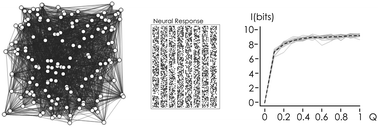The effect of connectivity on information in neural networks†
Abstract
We present a mathematical model that quantifies the amount of information exchanged in bi-dimensional networks of nerve cells as a function of network connectivity Q. Upon varying Q over a significant range, we found that, from a certain cell density onwards, 90% of the maximal information transferred I(Q) in a random neuronal network is already reached with just 40% of the total possible connections Q among the cells. As a consequence, the system would not benefit from additional connections in terms of the amount of I(Q), in agreement with the tendency of brains to minimize Q because of its energetic costs. The model may reveal the circuits responsible for neurodegenerative disorders in that neurodegeneration can be regarded as a connective failure affecting information.



 Please wait while we load your content...
Please wait while we load your content...